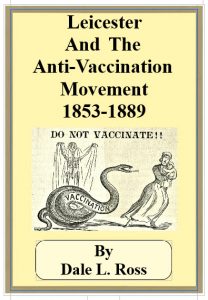DURING THE NINETEENTH CENTURY AND ESPECIALLY AFTER AN ACT OF 1853 made it compulsory for all infants over four months old in England and Wales to be vaccinated, opposition to the practice of vaccination increased steadily.
A further tightening up of compulsory measures was made after the smallpox epidemic of 1871, as a result of which a Select Committee was appointed by the government. The report of this committee confirmed the principle of compulsion amongst other recommendations, and these were embodied in new legislation by an Act of 1871, which made the law so stringent that, between 1871-76, only four of the local Boards of Guardians proved obdurate.
Leicester is taken in this article as an example of a town where the opposition to vaccination was particularly marked and where, due to the agitation caused, the various anti-vaccination forces had their greatest success in bringing about a change in the 1871 Act[1].
From the turn of the nineteenth century, Leicester, like many other towns, experienced a great increase in population. Existing housing and sanitary arrangements, especially drainage, soon proved inadequate. Leicester had for long an unenviable reputation as a town where typhus and contagious fevers were rampant[2].
In 1842, Edwin Chadwick’s Report on the Sanitary condition of the Labouring Population of Great Britain appeared. This did much to focus attention on the whole question of sanitary hygiene and the public health. Leicester was one of the towns visited by Chadwick in his search for data. The result of his investigations was published in the Summary to the report[3],
